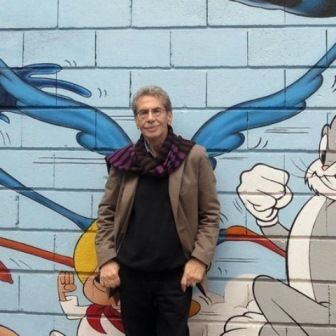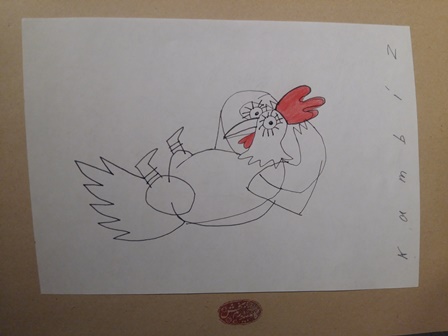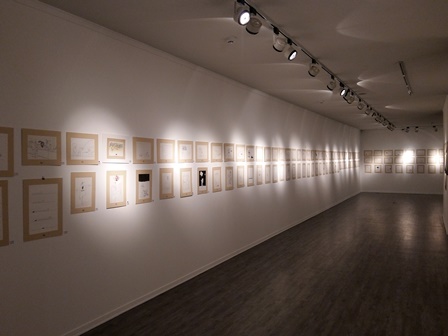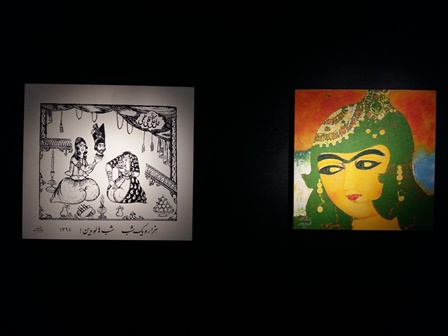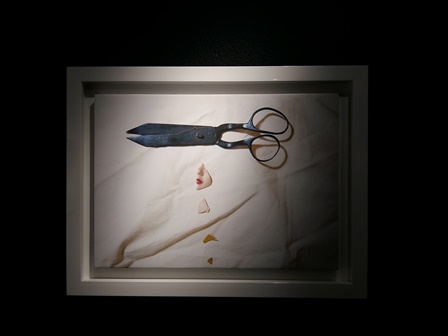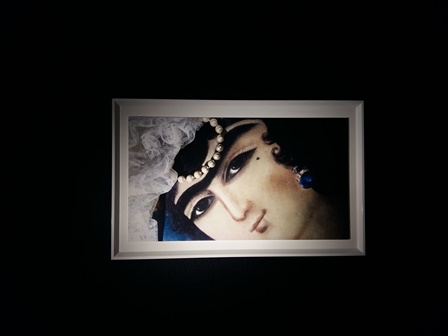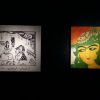Tandis Website|By Ali NoorPoor
translated by behrad sharifi
متن فارسی گفتگو
Kambiz Derambakhsh (born 1942 Shiraz, Iran) is a veteran artist in the fields of caricature, drawing and graphics. At the age of 15 Derambakhsh began his collaboration with Iranian reputable publications, along his 47 years of continuous work with domestic and international press, he has worked with foreign press such as The New York Times, Der Spiegel, Nebelspalter. Also he has taught in Fine Art university of Tehran. He has won prestigious international competitions in Japan, Germany, Italy, Switzerland, Belgium, Turkey, Brazil and Yugoslavia. He has been a jury in several international exhibitions and also received Legion of Honor from French government in 2014.
With his works, Kambiz Derambakhsh makes us to think about contemporary human, who may have any nationality or any role to play. With a thoughtful look he has experienced different visual elements and over the years he has reached to kind of enlightenment and by polishing has made it to an influential art. An important point is the element of line beside his rare ideas, which engage every viewer. These lines have become so personalized that even without artist’s signature they are recognizable. Smooth, simple and exciting lines, which are moving strongly in frame to deliver artist’s concept of thinking and make forms.
I studied at school of Fine Arts, but even at that time I was a famous caricaturist, I was working with respectable publications and everyone knew me. Hanibal Alkhas and Marcos Grigorian were my drawing teachers. I was working with famous newspapers; even my salary was more than my father’s who were an army officer. When I was fourteen my father was editor of army’s monthly journal, at that time a caricaturist was working there by the name of Tejaratchi. In summer holidays I met him there and his work impressed me and my father also encouraged me.
A few sessions I worked on his drawings, my first work was printed in the same journal. For a fourteen years old boy who his pocket money was five Tomans, hundred and fifty Tomans was very exciting. I left my studies and everything else and started to work hard, at first its money was interesting for me but later on I fell in love with caricature.
I was working with famous magazines like Etelaat Haftegi and Sepid Siah, Dr.Behzadi director of Sepid Siah magazine gave me a job and I had two paged in that magazine at that time I was about fifteen years old. Before that I was selling my paintings in manouchehri street, which was a tourist place; mostly I was painting historical places and miniatures.
Finding ideas is a creative work, for instant you cant teach a poet how to write a poem, talent and idea is an inner matter, which can be nurtured. Creativity can be obtained with practice but its basis should be inside that person in the first place. I have found some formulas for my own creativity and sometimes I tell younger artists how to work and find ideas. But some people wont teach to others and I think it’s wrong, because art is, in fact, like the rings of chain and artists are connected to each other. I have learned from others and others will learn from me, like the old days. The only artists who didn’t learn from each other were cavemen and their art was without imitation.
About his impressing ideas with simple and rational elements, Derambakhsh says: It’s not easy to reach this point; it needs years of hard work and effort. Today even in literature we see that stories have become shorter, people don’t have much time these days and they want to know everything as fast as possible. Best example that I can give you is Japanese haiku, which is too short and brief. This simplicity needs time and experience just like a diamond, which is a stone at first, but after many cuts it takes form and beauty. But art is more interesting because it always continues and it doesn’t have an end. When I started practicing drawing my work had too much details but by passing time it became simpler.
My characters were not like this at first, they become simpler over time, they found life and turned into creatures that are moving, feeling and they can convey their feelings without words. They are understandable for every nationality because they have international visual language. Even when it’s a cold weather they are wearing jackets, I have given them these feelings and they convey it to others. These characters don’t have mimic, eyes or mouth. BY facial expression you can find out about their state of mind, but my characters use body language to show a feeling or a concept.
At least I have done forty to fifty years of journalistic work and always I’ve adapted to the demands of people and editor, for example if there was a book fair in Frankfurt my works were about book, writers or censor ship; any topic which be needed by that particular time. These days, environmental issues need attention and there are some topics that are general such as war, peace and migration, they are international issues. In my works poetic and literary aspects have merged journalism. Each one is an artwork and they don’t have expiration date, there are works for thirty or forty years ago, which are new topics even in these days, there are always issues that we can’t fix.
From age of fourteen H had habit of going to café; I was living there. No one would bother me, it was a great place to work for me, and I was also able to look at people and society. No one would gain anything by sitting at a closed-door room; you have to live between people. In a café you can meet different people learn new things that can affect your work. In a café I work on paper and will keep those, which are interesting for me. At first I used to throw them out but after visiting a drawing exhibition in Germany where all the works were from artists draft I started to keep mine. In those work I have worked on many characters.
My father was a filmmaker and my brother was a photographer but I didn’t like to work with technique. Steps in photography from developing to print were hard for me. But these days photography has become easier, first I started with a G15 and took these photos without any previous experience. But I found out that these subjects have a visual connection with my works. All of this happened very fast, for example one I was having lunch with my sister in Paris, there was a market close by and within one hour I took these subjects.
Technique is not everything, if you are interested first you have learn drawing then you can use computers. There are young artists who are in hurry, they come to me with ten or fifteen works and ask me how they can print them or looking for a publisher. My own book was published after eleven years of work. They just think about money and fame, being an artist requires persistence, hard work and research. They have to follow young artists works and exhibitions, today it’s easy and by one click you can see many works and artists. But at my time it was hard and even we had to buy books from outside of country, most of the thing that I have learned were self-thought.



